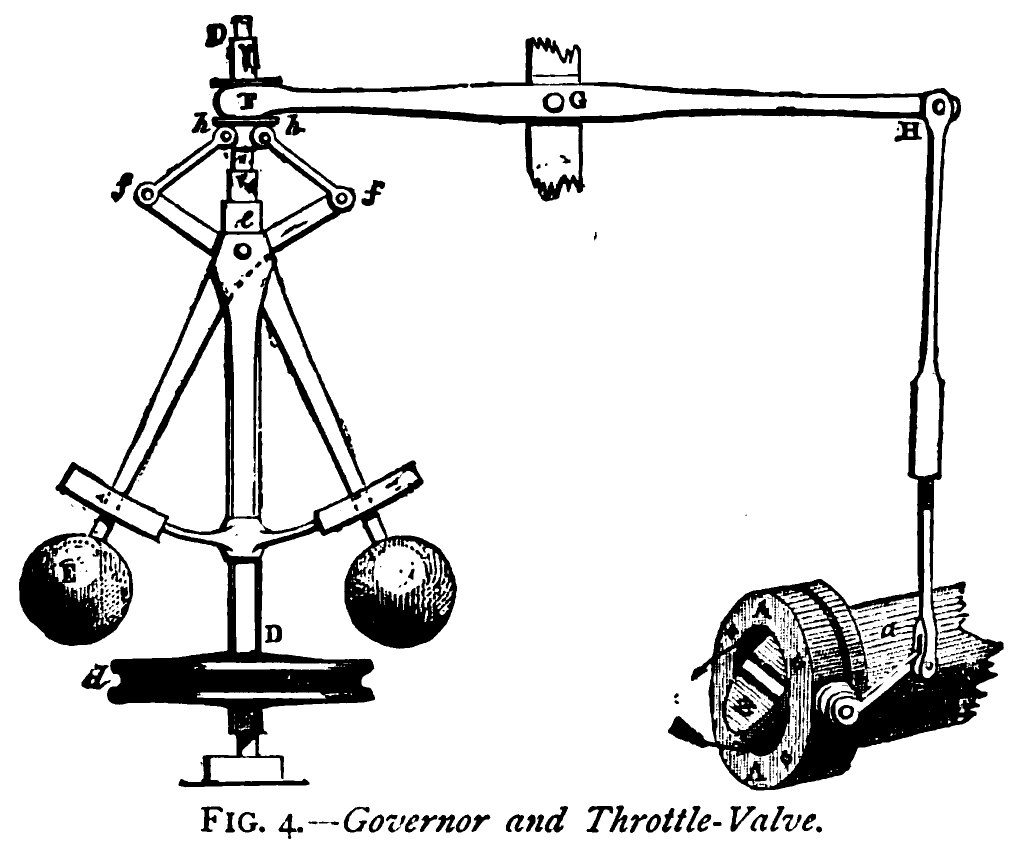
Rat Brain Cells.
M: Memories, dreams, thoughts, and other wonders of brain activities may be modeled as cybernetic loops, where neuronal impulses circulate in the connecting pathways of neurons and synapses and beyond. This is an excitingly new perspective in brain science, especially so if negative feedback and positive feedback controllers are explainable as something that emerge naturally.
P: Negative and positive feedbacks kind of remind me of the Chinese yin and yang symbols. The Korean flag has that. By what you say, yin is like contraction or negative feedback, and yang is like expansion or positive feedback.

Korea Goryeo Flag
M: Yes, and in Chinese Taoism yin and yang are intertwined as the Korean flag shows. Similarly, in nature multiple cybernetic loops are interlocked with both negative feedback and positive feedback present. Here is another diagram of cybernetic loop. It is slightly different from the one before. That one was drawn by engineers to model self-regulating mechanical systems. This one is by naturalists to model the actions of convergence or divergence in living things.

The basics of negative feedback control or regulation goes like this: A sensor provides a difference information to a controller. The difference comes from a threshold reference and a feedback output by another system.The controller produces an action output to reduce that difference. This output acts on the other system, and the other system responds. The response feeds a new status information back to the sensor for it to update the difference. And the cycle repeats. From the other system's point of view, whatever it does it receives a feedback from the controller, forcing it to converge its output to be equal to the threshold reference, albeit any disturbance from extenuating circumstances. That’s the mechanism of convergence feedback, also called self-regulation or negative feedback. The threshold value itself can change. When that happens, the cybernetic circuit will regulate the other system to converge onto the new threshold. Adjusting a thermostat setting or a stereo volume knob are examples of this. The room will have a new equilibrium temperature, or the music will have a new sound level, according to the adjustment setting.
Negative feedback control has another name called homeostasis - from Greek: homœos, "similar" and stasis, "standing still". Homeostasis takes place in the natural world, from within our body organs and cells, to animal and plant population balance, to all living things that ecologically interact with one another.

Temperature Regulation by ChancroVet.
One simple example of homeostasis is the mammals’ constant body temperature. How does a warm body maintain a constant temperature despite the heat or cold air? Cybernetics can explain this. First, some nerve endings extended from the spine act as sensors that detect body temperature by metabolism rates or chemical reactions. Then they send the difference information of actual temperature and a reference temperature to the brain or the spine (the controller). If the difference information indicates it is too hot, then the brain sends action signals to blood vessels and sweat glands (the other system). The blood vessels respond by expanding capillaries to dissipate heat and reduce the difference to the reference temperature. This cooling reaction continues until the temperature dips down below the reference temperature. When that happens the brain will reversely reduce the difference by signalling the capillaries to constrict and the skin to make goosebumps, till the temperature warms back up.
These expansion and contraction of capillaries, plus tightening of skin and other reactions, are what regulate the body temperature and put it at a constant level. Similarly, that is also how the populations in an ecosystem maintain their mutual balance. For example, when rabbits are abundant in an area, coyotes in that area will sense that. They will reduce the rabbit population by feasting on them. Then the coyote population increases, but it will be counteracted by a dwindling rabbit population. With less rabbits available for food the coyotes begin to lose its numbers to hunger or migration. Once the presence of coyotes is decreased, the rabbits get breathing rooms to multiply, which brings back the coyotes. And it goes on like this, with the populations of rabbits and coyotes going up-and-down around an equilibrium level. That’s population homeostasis.
In the case of constant body temperature, the sensor and controller are the nerves and the brain (or spine). But in the case of population balance between rabbits and coyotes, there is no physical sensor and controller present. The self-regulation just naturally happens, as if an invisible sensor and controller are hiding behind the scene, making sure any deviations from the population equilibrium is continuously reduced. That invisible controller is noted by the naturalist Alfred Russel Wallace, who coined the term survival of the fittest. His contemporary Charles Darwin popularized the term natural selection. But even Darwin found that survival of the fittest is a better abstract for his own theory of evolution so he adopted it as his own. Wallace mentioned this invisible controller by an analogy to James Watt’s steam engine that has a centrifugal governor. It was this invention of steam engines that led to the Industrial Age revolution.

Watt’s steam engine is a typical negative feedback control machine. By assembling a sensor, a threshold setter, a centrifugal governor, and a fuel intake into a cybernetic loop, Watt created an engine that can maintain a near-constant speed, regardless of variations in load or fuel supply. This adjustable steam engine is exploited to do the work of factory productions and goods transportation. Western civilization, followed by the rest of the world, is drastically changed by this. The change itself can be described as an evolutionary demarcation from one era into another. From the advent of steam engines to the present day, humans have been riding on the tsunami of industrial progression with no landmass of equilibrium in sight. Because no opposition force, be it spiritual or predatorial or economical or political , is present to reduce the geometric growth of machines. The equilibrium may come when the machine populations are saturated, when the resources that create and sustain their growths are running short or depleted, then scarcity will become the balancing force to check the growth of machines.
Wallace had also made observations on specializations of species. In his view specialization occurs when a population is subject to survival pressures. Such pressures don’t exist during the governor’s upswings, when resources are abundant and predators scarce, but are evident during the downswings, when resources are scarce and predators abundant. His phrase survival of the fittest is alluding to adaptation to the vicissitudes brought about by the actions of the invisible governor. This adaptation, or fitting into a niche by specialization, is seen in all species that face survival problems - blind bats using echolocation, moths using camouflage, and people using business or professional skills to survive. All business is niche business that specializes in something. Street food business is a tasty example of specialization.

Bugis Street Food.
Another interpretation of specialization is taken by the followers of Darwin. They view survival of the fittest as competition rather than adaptation. It is by specialization that a group or individual can compete and triumph over competitors and thereby lay claim to the prize of resources for survival. This model works well in artificially created sports games and businesses, for a period of time. Of course competition exists when desirable resources are limited. But any champion or great company or successful industry or dominant nation will find out that, with the passage of time, it cannot survive by competition alone. It is simply unsustainable. Sooner or later they must learn to adapt and cooperate in order to be sustainable. Unfortunately, Darwin’s competition model is far more popular than Wallace’s adaptation model. And so the human race of the industrial age is facing the problem of continuing competitions, as the other systems (Nature and people) keep reacting and changing under the guidance of a grand invisible governor.

Balancing Boy Rights Itself When Tilted.
The invisible cybernetic governor in population homeostasis is a spontaneous but definite phenomenon. It is not a hidden biological or mechanical puppet master. Something similarly cybernetic also exists in the world of chemistry and physics. In chemistry it is observed and called the Chartelier’s Principle, which states that ‘when a system at equilibrium is subjected to change in concentration, temperature, volume, or pressure, then the system readjusts itself to (partially) counteract the effect of the applied change and a new equilibrium is established.’ In physics it is observed by Newton and called the Third Law of Motion, which is that ‘for every action there is an equal and opposite reaction.’ The physical, chemical, and ecological realms have this in common: counteraction to changes of input to a balanced system. The counteraction is most sophisticated in the ecological realm as it is the governor or Mind in a cybernetic loop. The brain is minding the business of body temperature, and the steam engine is minding the business of wheel speed.
P: Wow, I did not know so much can be said about negative feedbacks.
M: There’s a lot more that can be said about negative feedback loops. The governor acts on the other system negatively, i.e. reducing the difference of inputs to the sensor by converging the other system’s feedback output to the threshold value. In living things, this negative action can trigger the other system to undergo internal changes, making it more specialized to adapt to the stress from the governor. Wallace used this to explain specialization, as well as diversity, of species. There are so many different kinds of street foods precisely because each food stall specializes in something: shaved ice, tempura, curry rice, nutritious sandwiches, rice stick soups, fishball soups, fried chickens, etc. Same thing happens in jobs: accountants, engineers, technicians, cooks, teachers, launderers, secretaries, and so on. Or selective breeding of dogs: golden retriever, shepherd, beagle, husky, chihuahua,... Such diversity emerges from specializations. There is also diversity not by specializations but by fundamental system breakups. These breakups, cumulatively, separate cats from dogs, the US from the Great Britain, the minds of schizophrenics from the CPU of Deep Blue, the computer that beat the former world chess champion Garry Kasparov. Ilya Prigogine alluded to this process of breakups in his book Order Out Of Chaos. For us, this type of diversity is related to iterations of positive feedback in a cybernetic loop, or what's commonly called divergence.
P: I was wondering when you are going to get to positive feedbacks.
No comments:
Post a Comment